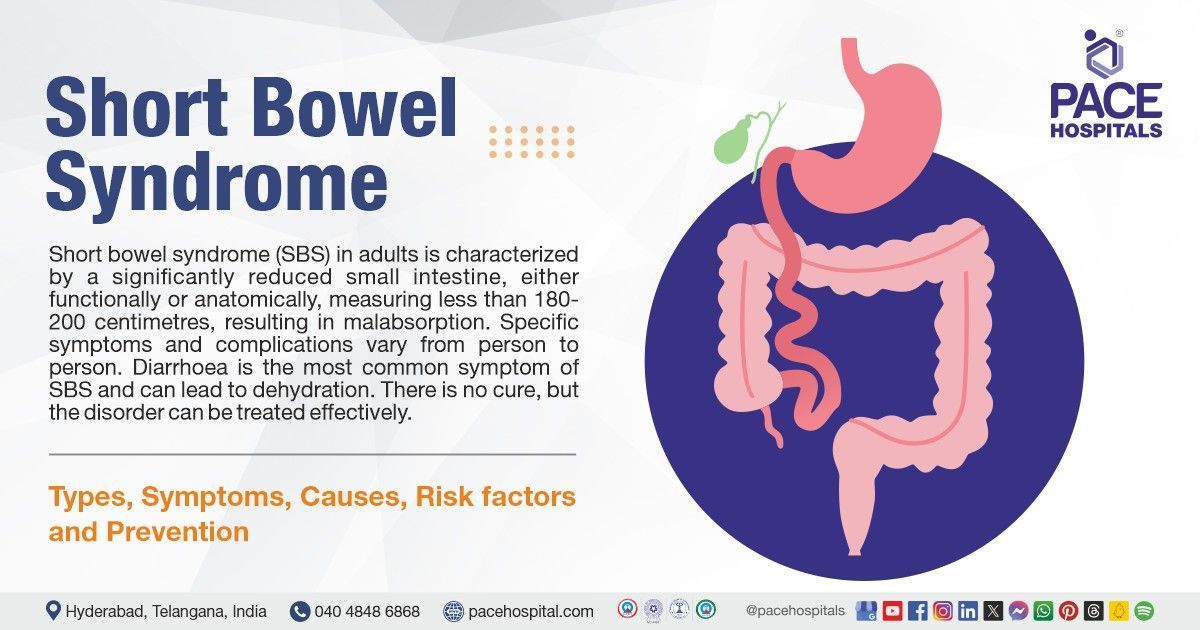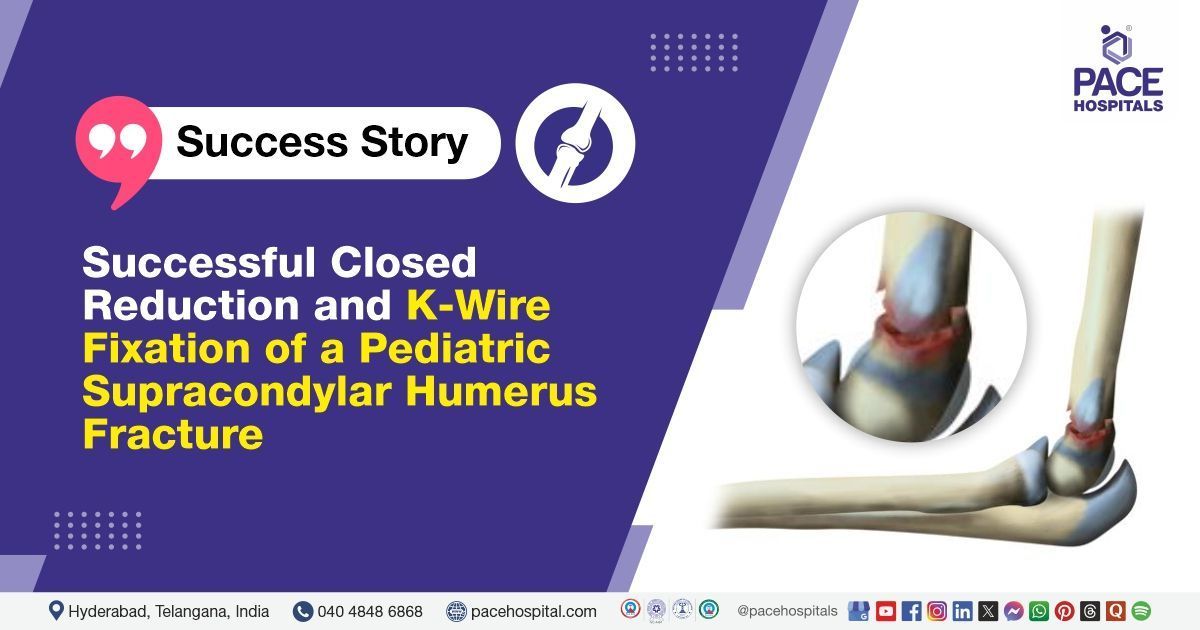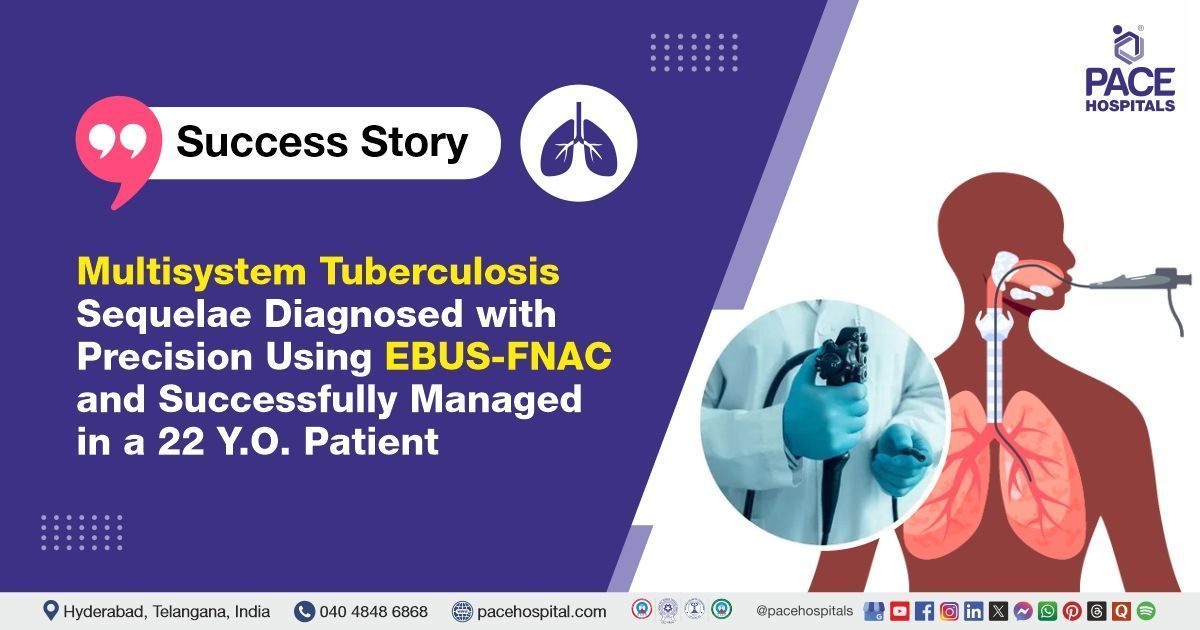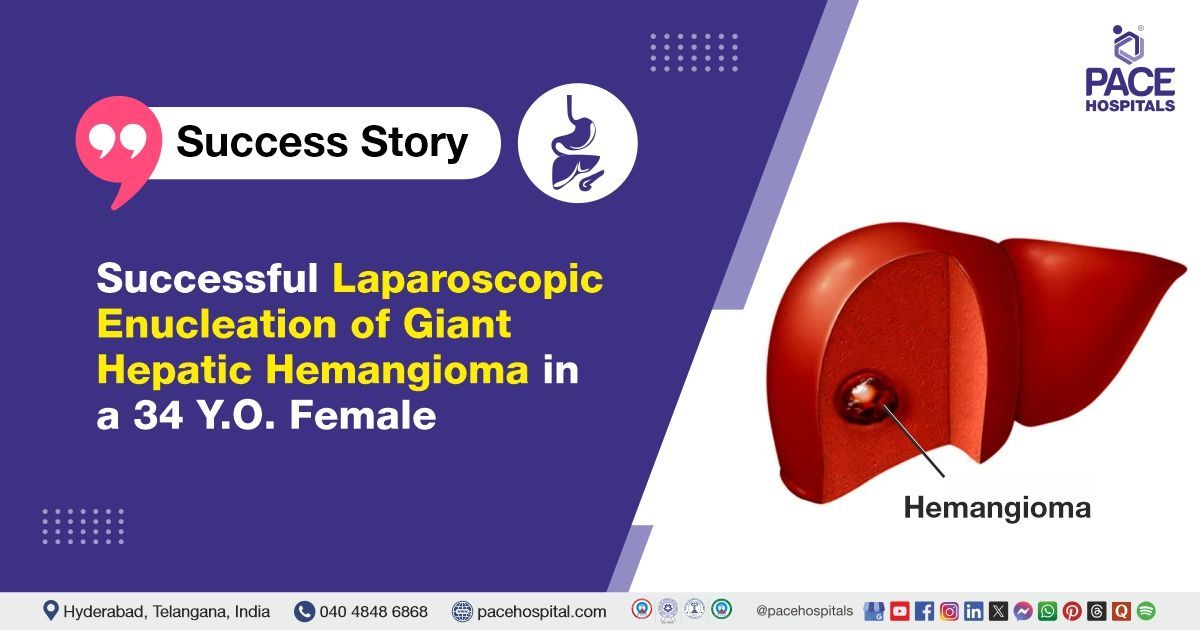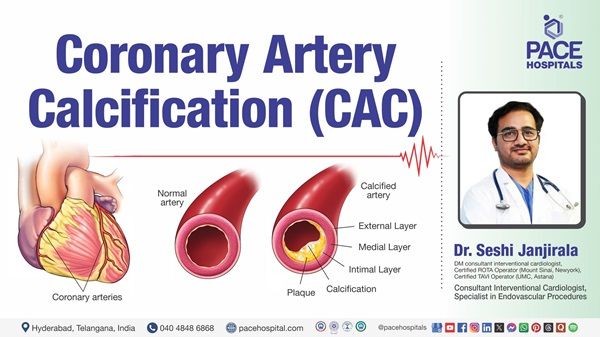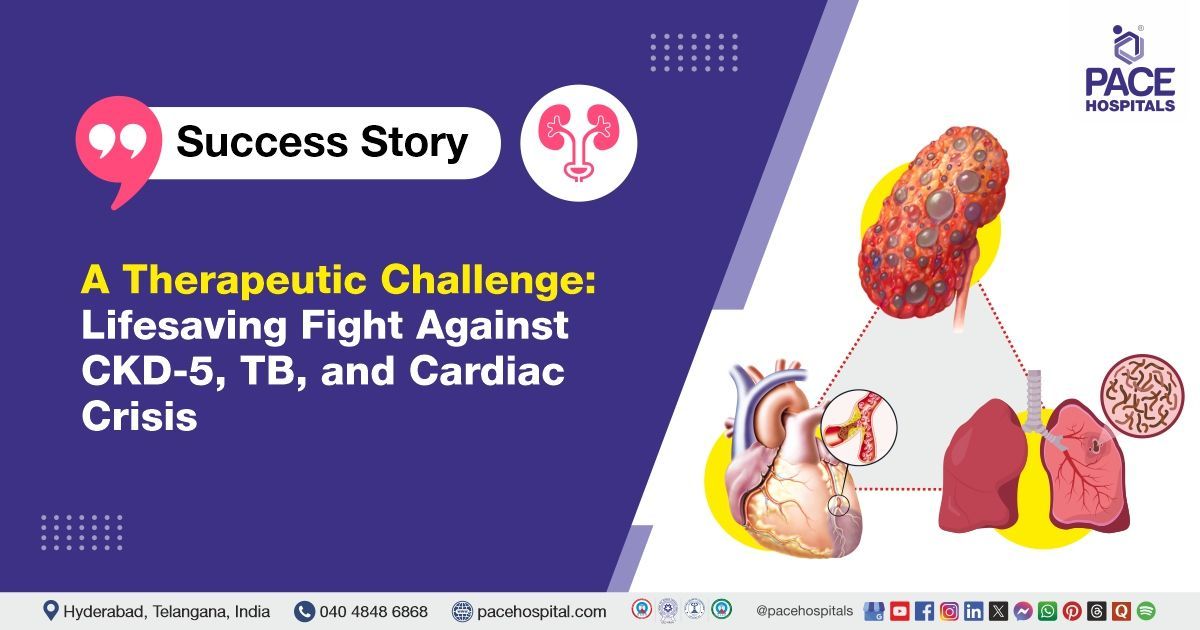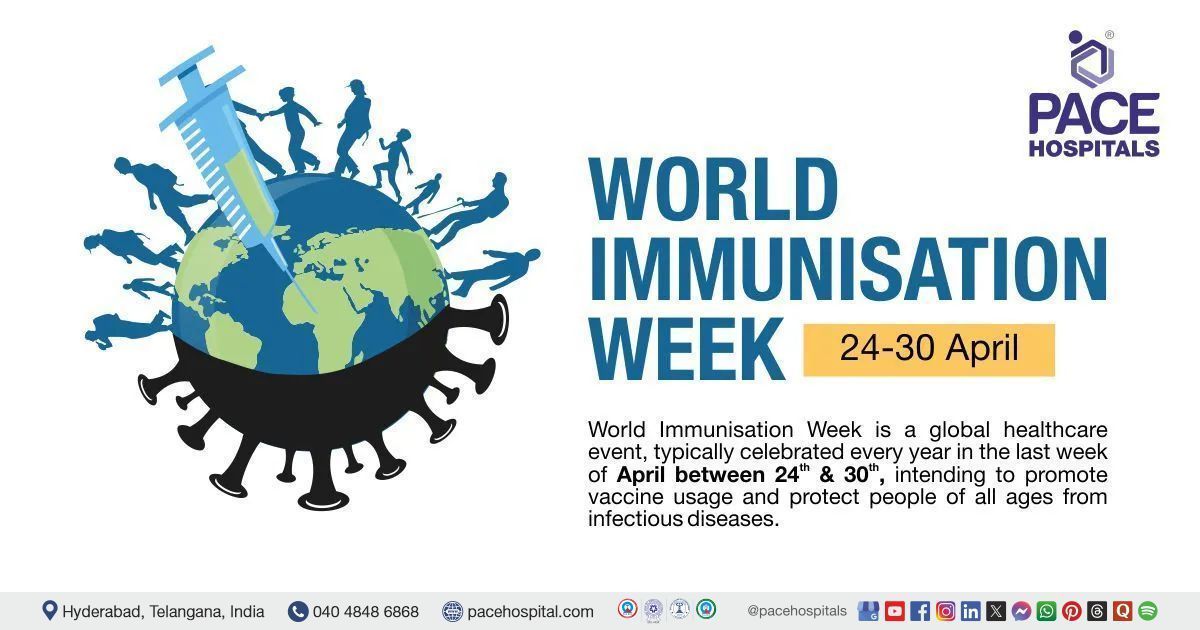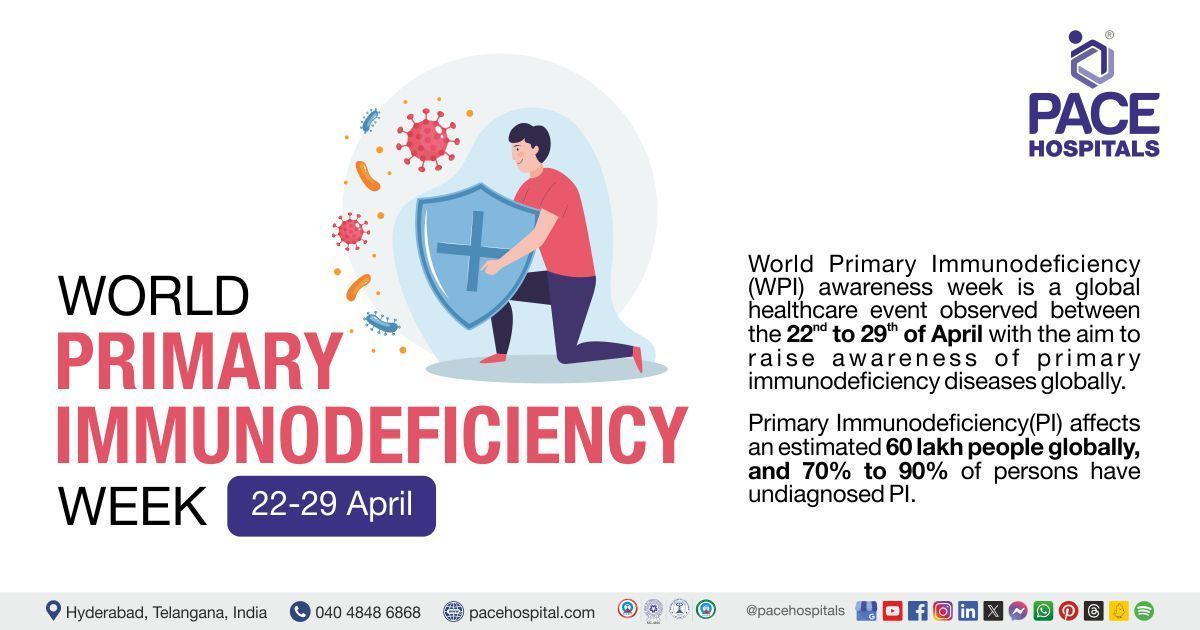Short Bowel Syndrome - Types, Symptoms, Causes, Risk Factors, Prevention
Short bowel syndrome definition
Short bowel syndrome (SBS) in adults is characterized by a significantly reduced small intestine, either functionally or anatomically, measuring less than 180-200 centimeters, resulting in malabsorption. In children, nutrient and fluid supplements are needed if the intestine is shortened by less than 25% of its expected length.
A healthy adult's small bowel (small intestine) is 275-850 centimeters long and divided into duodenum, jejunum, and ileum. It absorbs about seven liters of fluid and 1000 kilocalories daily, with most nutrient absorption occurring in the first 100 centimeters of the jejunum.
Specific symptoms and complications vary from person to person. Diarrhea is the most common symptom of SBS for individuals and can lead to dehydration. There is no cure, but the disorder can be treated effectively.
Short bowel syndrome meaning
Short bowel syndrome is a combination of three words.
- The term short is derived from the Proto-Germanic skurta, which means little length.
- The term bowel is derived from the late 14th century old French boele, which means intestines.
- The term syndrome is derived from a medical Latin word syndrome, which means many symptoms occurring together.
Short bowel syndrome prevalence
Short bowel syndrome is uncommon as the intestine often heals naturally. It develops in approximately 15% of individuals undergoing intestinal surgery. The overall occurrence of this condition is estimated at 3-4 cases per ten lakh people.
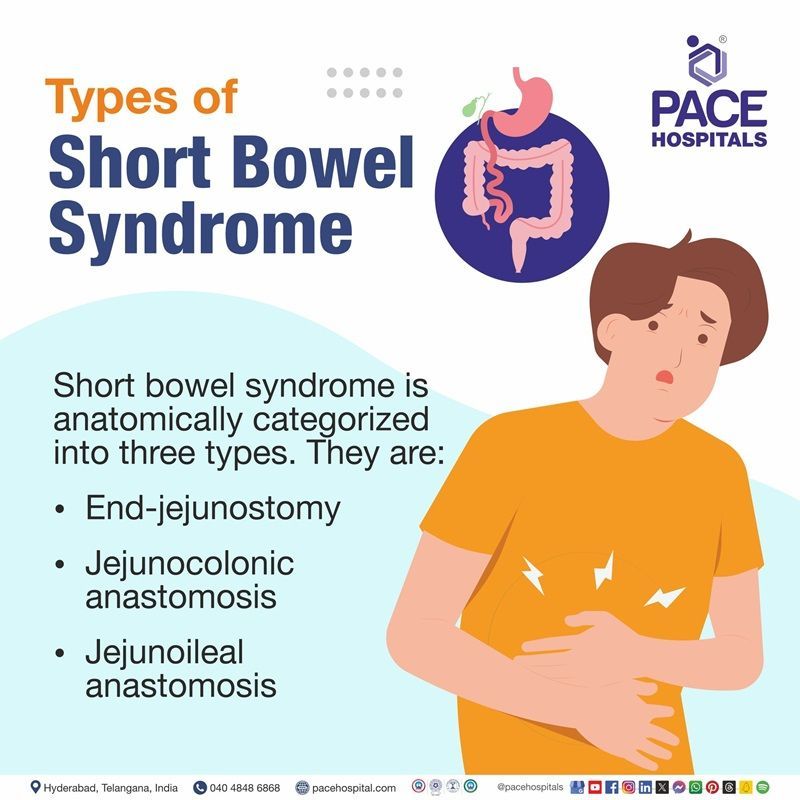
Short bowel syndrome types
Short bowel syndrome is anatomically categorized into three types. They are:
- End-jejunostomy: This surgery involves removing the colon, ileum, and part of the jejunum. The remaining jejunum is then connected to a surgically created opening in the abdomen, called an ostomy. This opening, known as a stoma, allows the stool to exit the body into a collection bag worn externally.
- Jejunocolonic anastomosis: The jejunum is connected to the large intestine, also known as the colon. This process is called anastomosis. The ileum and occasionally the muscle connecting the large and small intestines are removed. Portions of the colon might also be removed during this surgery, after which the remaining sections (jejunum and colon) are joined together.
- Jejunoileal anastomosis: Sections of the jejunum and ileum are removed, and the remaining portions are joined to the colon. This process is termed anastomosis. The colon remains entirely intact after surgery. Many individuals who undergo this procedure do not necessitate parenteral support.
Short bowel syndrome causes
Short bowel syndrome arises from conditions that impair the small intestine's ability to absorb nutrients. These conditions can be categorized into two primary types. They are:
Congenital short bowel syndrome: The underlying cause of congenital short bowel syndrome often remains unclear.
Acquired SBS: It is developed after birth and is more commonly seen than congenital short bowel syndrome. The common causes of acquired short bowel syndrome include:
- Surgical resection (removal)
- Various other diseases or medical conditions
- Injuries
All the causes of acquired short bowel syndrome, occurring according to age, are listed below:
Short Bowel Syndrome in infants and newborns:
- Necrotizing enterocolitis: Primarily affects premature or medically compromised infants. This condition involves intestinal tissue damage, specifically the death and shedding of the intestinal lining.
- Congenital disabilities
- Midgut volvulus: A condition where a segment of the intestine twists upon itself.
- Omphalocele: It is a congenital disability where a baby's intestines and other abdominal organs protrude through the belly button.
- Gastroschisis: A congenital disability where a baby's intestines protrude through a hole in the abdominal wall, typically located near the umbilical cord.
- Meconium ileus: A condition linked to cystic fibrosis, occurs when the intestine is blocked by meconium, a thick, sticky substance present at birth.
- Atresia of the small intestine: Abnormal intestinal development before birth can lead to narrowing, resulting in short bowel syndrome.
- Hirschsprung's disease: In rare cases, it can extend into the small intestine, contributing to short bowel syndrome.
Short Bowel Syndrome in older children and adults
- Crohn’s disease
- Trauma
- Cancer
- Surgery
- Radiation enteritis: This occurs when radiation therapy damages the intestinal lining, affecting both the small and large intestines.
- Ischemia:
- Due to a blocked blood vessel
- Bowel strangulation: A condition when intestinal obstruction cuts off blood supply to the intestine.
- Mesenteric vascular accidents: A condition that affects arteries of the abdomen supplying blood to the intestine.
Short bowel syndrome risk factors
The risk factors of congenital short bowel syndrome remain unclear. However, acquired short bowel syndrome is more prevalent. The risk factors for acquired short bowel syndrome encompass all its potential causes.
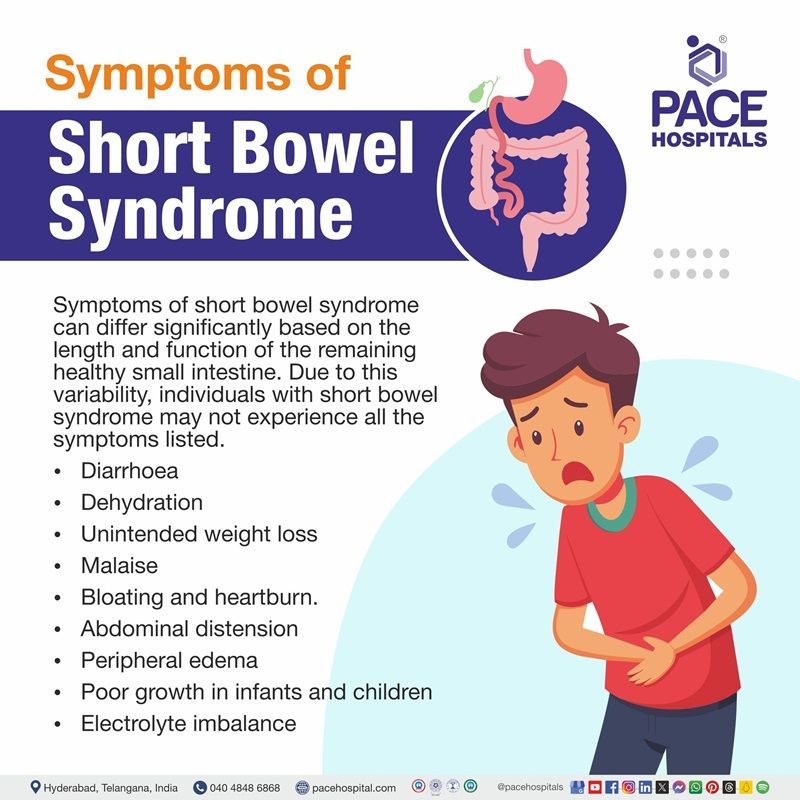
Short bowel syndrome symptoms
Symptoms of short bowel syndrome can differ significantly based on the length and function of the remaining healthy small intestine. Due to this variability, individuals with short bowel syndrome may not experience all the symptoms listed:
- Diarrhea
- Dehydration
- Unintended weight loss, loss of muscle mass, temporal wasting (muscle loss giving temporal a hollow shape)
- Malaise (a general feeling of weakness), lethargy, cramping, fatigue
- Bloating and heartburn
- Abdominal distension
- Peripheral edema (swelling of the tissues of the legs and feet)
- Poor growth in infants and children
- Electrolyte imbalance
Due to poor absorption of the micronutrients, various deficiencies and associated symptoms are observed. They are:
- Vitamin A deficiency: Symptoms include night blindness, xerophthalmia, and corneal ulceration.
- Vitamin B deficiency: Symptoms include stomatitis (inflammation of the mouth), edema, anemia, peripheral neuropathy (damage to the cells outside the CNS), and irregular heartbeats.
- Vitamin D deficiency: Symptoms include tetany (muscle spasms), and paresthesia (feeling of being on “pins and needles”).
- Vitamin E deficiency: Symptoms include paresthesia, tetany, and ataxia (loss of voluntary muscle coordination)
- Vitamin K deficiency: Symptoms include prolonged bleeding, and a tendency to bruise easily.
- Iron, vitamin B12, and zinc deficiency: Symptoms include lethargy, and dyspnea (shortness of breath upon exertion).
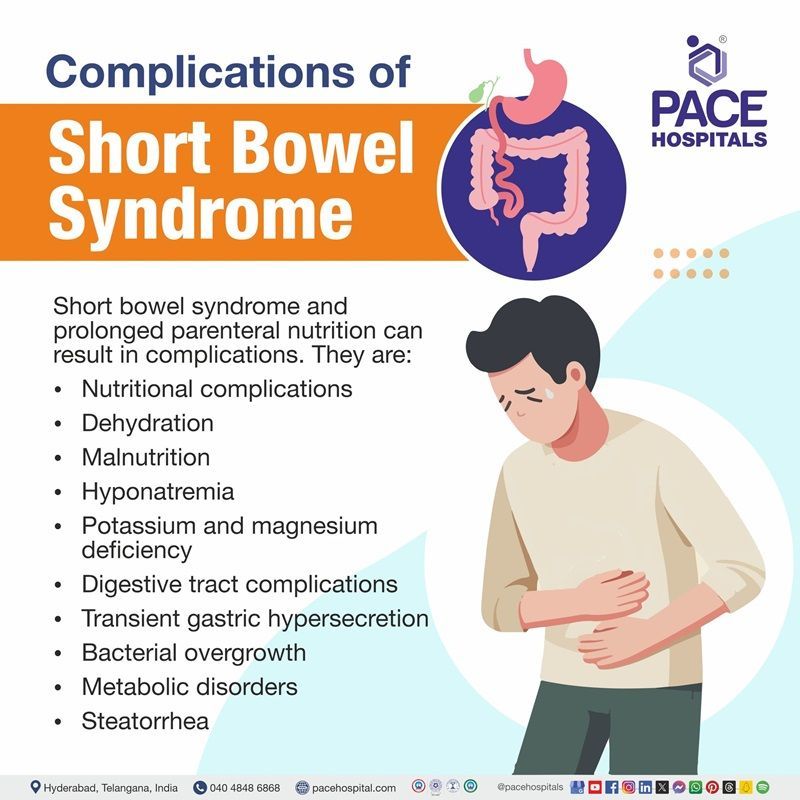
Short bowel syndrome complications
Short bowel syndrome and prolonged parenteral nutrition can result in complications. They are:
Nutritional complications
- Dehydration: A condition in which the body loses too much water and other fluids required for normal functioning.
- Malnutrition: A condition caused by a lack of calories or essential nutrients, such as vitamins and minerals.
- Hyponatremia: A condition in which the amount of sodium in the body is lower than usual.
- Potassium deficiency: Potassium deficiency occurs when there are abnormally low levels of potassium in the body. It is also known as hypokalaemia.
- Magnesium deficiency: Magnesium deficiency is a condition in which the body's magnesium levels are lower than usual. This condition is referred to as hypomagnesemia.
Digestive tract complications
- Transient gastric hypersecretion: A condition in which the body's gastrin levels increase, resulting in increased stomach acid production.
- Bacterial overgrowth: A rise in the number of bacteria or a change in the type of bacteria in the small intestine
- Metabolic disorders: Secondary lactose intolerance, d lactic acidosis
- Steatorrhea: Excess fat in stools
Other complications
- Nephrolithiasis due to hyperoxaluria
- Bone illnesses, such as osteoporosis or reduced bone mass, referred to as osteopenia
- Renal failure, a condition in which the kidneys stop functioning and are unable to eliminate waste and excess water from the blood or maintain the body's chemical balance.
- Calcium oxalate kidney stones, the most common type of kidney stones.
- Cholelithiasis known as gallstones. These are hard, pebblelike fragments of material that form in the gallbladder.
- Cholestasis secondary to intestinal failure-associated liver disease
Short bowel syndrome diagnosis
Extensive small bowel removal following major bowel surgery can lead to severe diarrhea and weight loss, indicative of short bowel syndrome. This condition may improve over time as the remaining intestine adapts. Diagnosis performed to confirm short bowel syndrome include:
- Medical history: It includes information about past surgeries and medical conditions.
- Physical examination: Examining the symptoms of dehydration, malnutrition, and specific symptoms of vitamin deficiencies.
- Blood tests
- Complete blood test: To evaluate anemia, the specific type of anemia is crucial in identifying associated nutritional deficiencies. Plasma albumin levels are an additional parameter considered in this assessment.
- Liver function test: This test evaluates levels of aspartate transaminase (AST), alanine transaminase (ALT), blood urea nitrogen (BUN) and creatinine, serum electrolytes, prothrombin time (PT) and international normalized ratio (INR).
- Imaging test
- X-ray: Chest X-ray and gastrointestinal X-ray
- Abdominal computed tomography
- Abdominal ultrasonography
- Stool culture: To evaluate infection-causing organism
- Fecal fat test: To evaluate fat in stools
- Bacterial overgrowth breath test: Examining gases from breath to evaluate bacterial growth in the intestine.
- Colonoscopy: Examine the colon with the endoscopy through the rectum.
- Endoscopy: To examine the upper gastrointestinal (GI) tract
- Liver biopsy: In case of liver damage
Short bowel syndrome treatment
Short bowel syndrome treatment focuses on managing specific symptoms in each individual. Treatment plans vary widely based on factors such as the part and extent of the affected intestine, whether the colon is involved, the person's age, overall health, medication tolerance, and personal preferences. Treatment options for short bowel syndrome are diverse and complex, requiring highly individualized care. Short bowel syndrome treatment aims to accelerate and enhance absorption by intestinal adaptation (the body's ability to absorb nutrients using the remaining healthy intestine) while providing necessary nutritional support.
Short bowel syndrome nutritional management
Following surgical removal or nonfunctioning of a portion of the small intestine, many individuals require total parenteral nutrition (TPN). TPN delivers essential nutrients, including proteins, carbohydrates, vitamins, minerals, trace elements, and sometimes fats, directly into the bloodstream, bypassing the body's normal digestive process. Prolonged TPN use can lead to various complications. Over time, some individuals with short bowel syndrome may be able to discontinue TPN through a combination of dietary adjustments, medications, and, in certain cases, additional surgery.
Short bowel syndrome diet
Patients with short bowel syndrome are encouraged to consume food whenever possible to stimulate intestinal absorption and promote adaptation. A standardized diet does not exist for this condition. Instead, dietary plans are individualized based on factors such as the extent of small bowel resection and the functionality of the remaining bowel. Frequent, small meals are generally recommended over fewer, larger ones. Oral rehydration solutions may be prescribed to maintain adequate fluid balance.
Short bowel syndrome medications
Pharmacologic treatment aims to enhance intestinal adaptation. A gastroenterologist improves the remaining bowel function by using medications and dietary adjustments, increasing the likelihood of long-term nutritional independence.
- Glucagon-like peptide-2 (GLP-2) analogue: Used to promote intestinal adaptation.
- Antidiarrheals: Helps to treat a symptom, diarrhea
- Histamine-2 receptor blockers and proton pump inhibitors: Used to maintain gastric hypersecretions.
- Human growth hormone: Helps in intestinal absorption and adaptation.
- Pancreatic enzyme replacement therapy: It is used to help increase digestion.
- Antibiotics: Used to treat any bacterial infections.
Surgery for short bowel syndrome
A variety of surgical procedures are available. Generally, physicians recommend surgical procedures only when all the other treatment options do not effectively treat the condition. Surgery options for short bowel syndrome are categorized as mentioned below:
Non-transplant surgery
This type of surgery helps to artificially improve the length of the bowel. Two main procedures used are:
- Bianchi procedure: The Bianchi procedure lengthens the bowel by splitting and rejoining a dilated section.
- STEP procedure: Serial transverse enteroplasty (STEP) is a surgical procedure to lengthen the small intestine. It is often performed in children with sufficient remaining bowel for functional restoration.
This type of surgery also helps to widen and narrow the abnormal bowel. The procedures include:
- Stricturoplasty: To widen the abnormally narrowed area
- Intestinal tapering: To narrow the abnormally widened area.
- It is considered for individuals, particularly those experiencing TPN-related complications like liver failure or who have not achieved adequate nutritional status with other treatments.
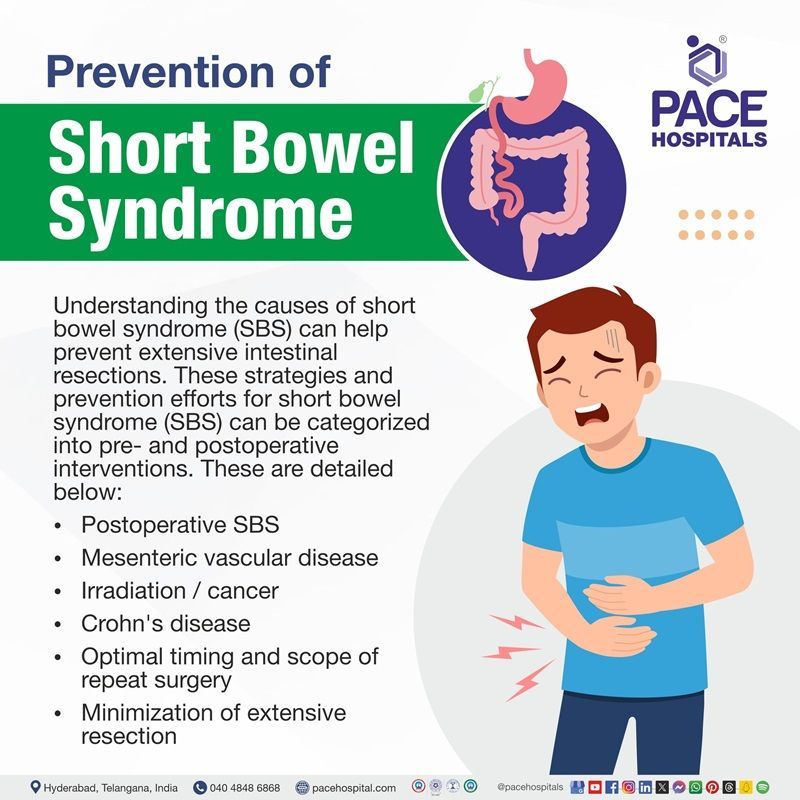
Short bowel syndrome prevention
Understanding the causes of short bowel syndrome (SBS) can help prevent extensive intestinal resections. Prevention strategies often vary based on the underlying condition. These strategies and prevention efforts for short bowel syndrome (SBS) can be categorized into pre- and postoperative interventions. These are detailed below:
Pre-operative strategies
Preoperative strategies focus on managing the underlying condition. Strategies based on causes are:
- Postoperative SBS: Prevent surgical errors, accurately diagnose intestinal ischemia, and exercise caution in managing the open abdomen.
- Mesenteric vascular disease: Early identification and selective use of second-look procedures.
- Irradiation/cancer: Reduce radiation exposure, employ adjunct therapies, and perform optimal surgical resection.
- Crohn's disease: Enhanced medical management, precise diagnosis, and selective performance of bowel-conserving surgical interventions
- Trauma: Accurately diagnose intestinal ischemia and effectively manage an open abdomen.
Post-operative strategies
Postoperative approaches aim to minimize bowel resection during surgery.
- Optimal timing and scope of repeat surgery
- Minimization of extensive resection
- Emphasis on minimal resection techniques
- Stricturoplasty
- Serosal patch repair
- Bowel tapering and lengthening
- Intestinal recruitment
- Preservation of adjacent digestive organs.
Frequently Asked Questions (FAQs) on Short bowel syndrome
What is the role of imaging studies in the diagnosis of short bowel syndrome?
Imaging studies have a great impact on the diagnosis of short bowel syndrome (SBS). Enteric problems such as bowel obstruction can be identified by abdominal computed tomography (CT). Short bowel syndrome develops gallstones. Symptoms are consistent with biliary colic or cholelithiasis and choledocholithiasis. Abdominal CAT scan helps physicians to identify and assess bowel obstruction.
What is the role of liver biopsy in the diagnosis of short bowel syndrome?
Liver biopsy has a major impact on the diagnosis of short bowel syndrome. It assesses the health of the liver and shows the extent of liver damage. Before liver biopsy, an ultrasound is carried out on a patient to evaluate the presence of Chilaiditi syndrome (the presence of a small bowel between the liver and abdominal wall.
What are the factors considered in the selection of surgery for short bowel syndrome?
The goal of any surgery will be to improve the quality of life of the patient. Prior to surgery, the following factors like bowel length, bowel function, bowel dilation, and bowel caliber are considered. Along with these factors, the age of the patient is considered, and the surgeon looks for any possible complications.
What are the possible complications of surgery?
Possible complications associated with surgery are intestinal bleeding, diarrhea, incision breaking open, the intestine pushing through the incision into the belly, pus formation, pus collecting in the small bowel, and scar tissue that causes intestinal blockage.
When is surgery indicated in the treatment of short bowel syndrome?
Surgery is indicated in certain cases usually when all the other therapeutic options such as parenteral and eternal nutrition or pharmacological bowel compensation have been exhausted or in certain other cases where the patient develops complications with prolonged parenteral nutrition.
How is short bowel syndrome diagnosed?
Diagnosis of short bowel syndrome (SBS) is carried out based on a detailed patient history and a variety of tests including laboratory tests and various X ray studies. A complete blood count helps in determining if the patient is anemic. Types of anemia can relate to specific nutritional deficiencies. Various imaging techniques like X-ray (to detect signs of obstruction) computed tomography (CT), and magnetic resonance imaging (MRI) of the abdomen are carried out to assess short bowel syndrome.
What is adaptation?
Adaptation is the second phase of short bowel syndrome which lasts for about 1 to 2 years. It involves adaptive changes of the small bowel (remaining bowel) to increase bowel surface area for nutrient absorption and slow down intestinal transit to make time available for absorption.
How is short bowel syndrome treated?
Short bowel syndrome (SBS) is managed by nutritional support to maximize the absorptive surface area of the remaining intestine. This involves parenteral as well as enteral nutrition which promotes intestinal adaptation. Patients with intestinal failure will require either lifelong parenteral nutrition or intestinal transplantation.
What are the contraindications to surgery for short bowel syndrome?
End-stage liver disease is one of the contraindications for surgery in patients with short bowel syndrome because in this patient transplantation seems to benefit more. For non-transplant surgery bowel length should be conserved during bowel resection. Only in selected patients bowel lengthening process be considered.
What is the role of parenteral nutrition in the treatment of short bowel syndrome?
Patients who develop short bowel syndrome (SBS) following bowel resections are usually fed using total parenteral nutrition. The main goal in these patients is to enhance intestinal adaptation and render the patient free of total parenteral nutrition.
What is included in long-term monitoring of short bowel syndrome?
Short bowel syndrome patients require lifelong follow-up. Patients on parenteral nutrition require frequent monitoring of serum chemistries, liver function tests, and levels of vitamins, minerals, and trace elements. Single or multiple organ transplants are monitored. Their cases are followed closely. The post-operative complications that must be identified early include organ rejection and opportunistic infection.
Share on
Request an appointment
Fill in the appointment form or call us instantly to book a confirmed appointment with our super specialist at 04048486868

